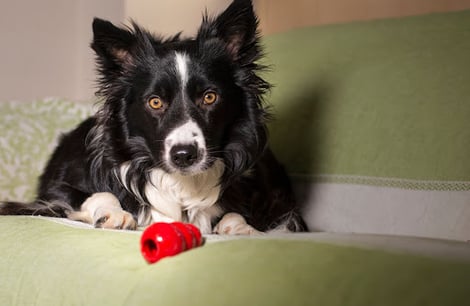Entertaining and Exercising Your Pet with Safe Dog Toys

Dogs need to chew, exercise, and play, and finding safe dog toys is a fun part of being a pet parent.
But some toys and chewable items can hurt your dog’s mouth or tummy, so it’s important to know how to find toys that will challenge your creature without sending them to the vet or the dentist.
Luckily, there are lots of options out there (maybe too many!), and you don’t have to break the bank to find toys that will entertain your pooch and keep them fit.
There are three main categories of dog toys: brain toys, chew toys, and fetching toys. What does a pet parent need to know before going on a shopping spree?
Toys that Challenge Your Dog’s Brain
Dogs like projects, and dogs with separation anxiety need extra stimulation so they don’t act out and destroy things. One of the best things you can do for a dog of any age is to create mental challenges for them. You can do this without investing in fancy items by hiding healthy dog treats or kibbles in unusual places. Or try wrapping them up in a towel to see if the dog can figure out how to get them out.
Pet stores have lots of fun, sturdy puzzles, and some will let your pooch try one out at a store to make sure they like it. Puzzles usually have different compartments that the dog needs to open with their paw or nose to get a treat. Some people like to give their dog a puzzle before leaving them alone, so they can focus on that instead of missing their person.
Talk to a veterinarian or knowledgeable pet store employee about the safety of puzzles, to figure out if you need to supervise at all times, or if your pet is safe being left alone with the puzzle.
Kongs—firm rubber objects that often have a hole for peanut butter (make sure there’s no xylitol in the peanut butter!) or other treats—are fun for your dog to bounce around. Many dogs enjoy the sensation of chewing a kong, too. Dogwood Veterinary Clinic recommends that the opening of the kong should be smaller than your pet’s bottom jaw, but the whole toy needs to be big enough so your dog can’t swallow it.
Pet stores also sell treat-dispensing balls and various textured surfaces that you can use to hide treats or slow your chowhound down.
Toys for Chewing
If you choose to take your dog to the pet store, they will get very excited about the dozens of chewable treat options (usually at nose level). Some of these treats can help reduce plaque and tartar on your dog’s teeth. Look for chew toys with the Veterinary Oral Health Council (VOHC) seal of approval.
But you need to help them make good choices. If they chew on something too hard, they can break or damage teeth or gums. PetMD recommends against giving dogs bones, antlers, nylabones, or anything that you can’t press your fingernail into.
Also avoid toys that have small parts, or stuffed animals where they can remove and ingest the stuffing. Dogs should always be supervised with sticks, too. They can splinter and cause serious problems.
Chew Treats
When it comes to chew treats, look for those approved by the Veterinary Oral Health Council (VOHC). The organization has approved some soft rawhides, dental chews, dental sticks, and other items.
The Bone Conundrum
Like their wild relatives, most dogs are crazy about bones. But some bones can be dangerous. Cooked bones should always be off-limits. They can splinter and puncture delicate organs.
There are conflicting opinions out there about whether it is safe to give dogs raw bones from the butcher shop or pet store.
Animal Dentistry & Oral Surgery reports that fractured teeth are common problems for dogs, and most of them are caused by chewing on objects that are too hard for their teeth. Their teeth are designed to cut and tear meat, not chew hard bones. This organization votes “no bones.”
PetMD agrees that cooked bones, including smoked or baked bones, are dangerous. But they note the benefits of chewing on the attached soft tissues of raw bones. If you want to give your dog raw bones, they recommend the following:
- Bones should be as large as your dog’s head.
- They should be sourced from a reputable butcher.
- Follow food hygiene rules to avoid foodborne illness.
- Consider grinding bones into your dog’s meals.
If you are worried about the dangers of bones, you can always opt for chews that are made of sturdy rubber or rope.
Safe Toys for Fetching
Some dog breeds or mixes love to fetch, and others just don’t have the instinct. If your dog likes to fetch, fetching sessions are a good way to wear them out. Unless you are an Olympian or a pro baseball player, you can increase your distance by using a tennis ball flinger. Kongs are reliable fetching toys, and there are all kinds of sturdy balls available at stores.
Some dogs like tugging and fetching other kinds of sturdy and stretchable toys, and for those who are inclined, there are lots of safe, flexible frisbees.
If your dog wants to fetch tennis balls, make sure the balls are big enough that they can’t get stuck in their throat. And don’t let them get in the habit of chewing the balls because they can damage their teeth, too.
Playtime Is Quality Time
Dogs are important family members in their households (humans and other dogs). For many dogs, daily walks are their favorite time of the day. See our tips for walking your dog.
Puppy socialization classes are a great way to introduce your dog to new situations and objects.
Pet parents who have questions can talk to veterinarians, trainers, and behaviorists about age-appropriate games, activities, and toys for pets.
Whether it’s leash walks, off-leash dog parks, or playing in the yard or home, pet parents and dogs benefit from playtime.

